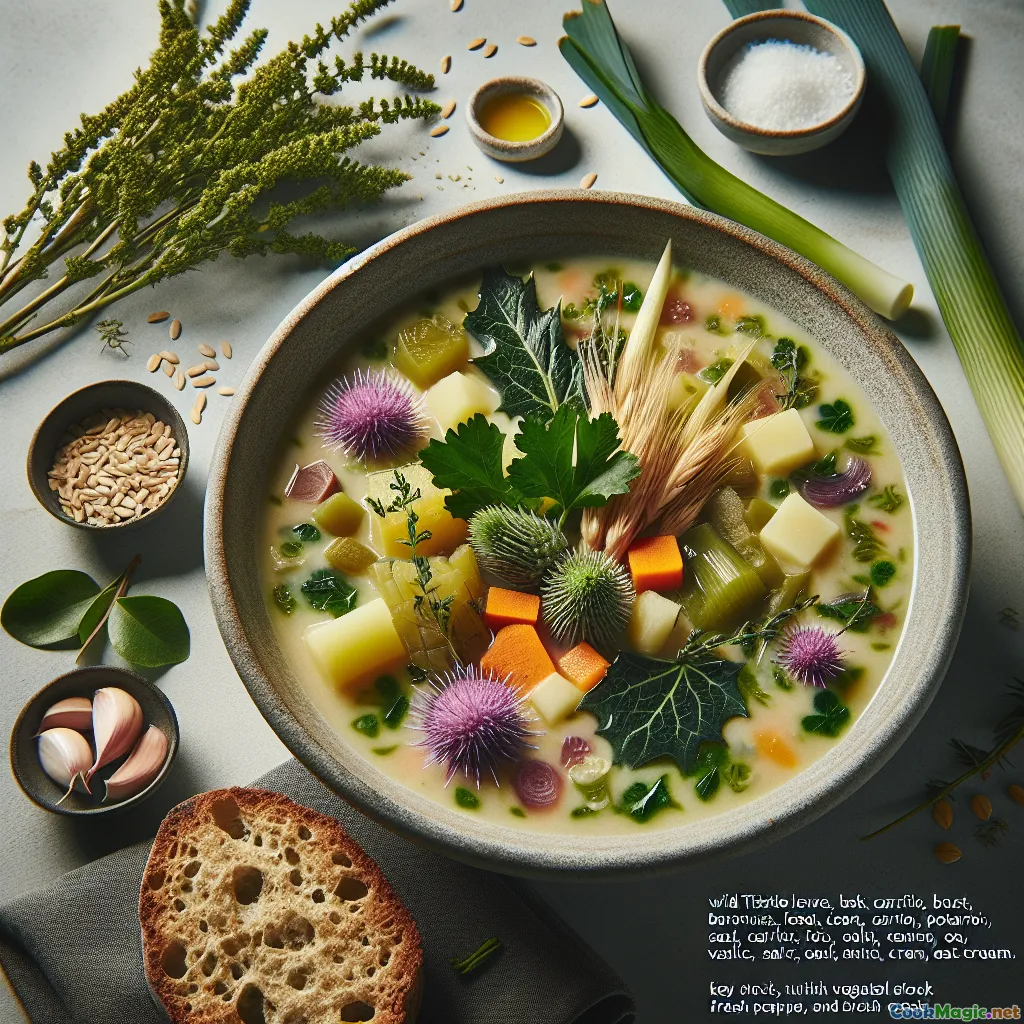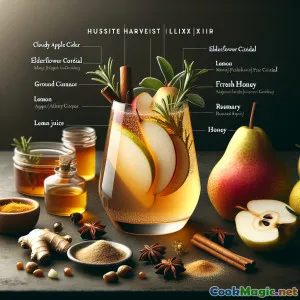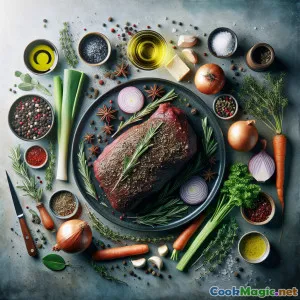
Rostico Zuppa Scozzese di Cardo e Verdure a Radice
(Hearty Scottish Thistle & Root Vegetable Soup)
(0 Recensioni)0
983
luglio 13, 2025
Segnala un problema
Ingredienti
-
100 grams Foglie di cardo selvatico
(Ammollato e privato delle spine; il cardo giovane proveniente da zone sicure e prive di pesticidi è ideale)
-
80 grams Grani d'orzo
(orzo perlato consigliato)
-
1 medium Porro
(Lavato e affettato)
-
2 medium Carota
(A dadini)
-
1 medium Pastinaca
(A cubetti; aggiunge la dolcezza autentica delle terre alte)
-
1 large Patata
(Pelato e a cubetti)
-
1200 ml Brodo di verdure
(Può sostituire il brodo di pollo con una versione non vegetariana)
-
2 cloves Aglio
(Tritato finemente)
-
3 sprigs Timo Fresco
(o 1 cucchiaino di timo secco)
-
1 tsp Sale
-
0.5 tsp Pepe nero
(Macina fresca preferita)
-
60 ml Crema di avena
(Aggiunge cremosità, usa la panna se preferisci)
-
2 tbsp Prezzemolo fresco
(Tritato, per guarnire)
-
4 slices Pane Bannock
(Contorno tradizionale scozzese)
(Ammollato e privato delle spine; il cardo giovane proveniente da zone sicure e prive di pesticidi è ideale)
(orzo perlato consigliato)
(Lavato e affettato)
(A dadini)
(A cubetti; aggiunge la dolcezza autentica delle terre alte)
(Pelato e a cubetti)
(Può sostituire il brodo di pollo con una versione non vegetariana)
(Tritato finemente)
(o 1 cucchiaino di timo secco)
(Macina fresca preferita)
(Aggiunge cremosità, usa la panna se preferisci)
(Tritato, per guarnire)
(Contorno tradizionale scozzese)
Nutrizione
- Porzioni: 4
- Dimensione Porzione: 1 ciotola (300ml)
- Calories: 210 kcal
- Carbohydrates: 38 g
- Protein: 6 g
- Fat: 3 g
- Fiber: 8 g
- Sugar: 7 g
- Sodium: 650 mg
- Cholesterol: 0 mg
- Calcium: 74 mg
- Iron: 2.1 mg
Istruzioni
-
1 - Preparare il Cardo Selvatico:
Indossando i guanti, tagliare attentamente le foglie di cardo. Rimuovere spine e gambi legnosi. Mettere in ammollo in acqua salata fredda per 10 minuti, quindi risciacquare e sminuzzare.
-
2 - Tritare le verdure:
Taglia a cubetti la carota, il pastinaca e la patata. Affetta il porro, trita l'aglio e prepara tutte le altre verdure.
-
3 - Base Soffritto:
In una pentola dal fondo pesante a fuoco medio, aggiungi un filo d'olio. Soffriggi porro e aglio per 2–3 minuti fino a che non sprigionano un aroma.
-
4 - Cuocere Verdure:
Aggiungi carota, pastinaca e patata. Cuoci, mescolando, per 5 minuti fino a quando i bordi si ammorbidiscono.
-
5 - Zuppa in cottura lenta:
Versare il brodo vegetale. Aggiungere orzo, cardo, timo, sale e pepe. Cuocere a fuoco basso per 30-35 minuti, mescolando di tanto in tanto fino a quando orzo e verdure sono teneri.
-
6 - Termina e Frulla:
Per una zuppa cremosa, frulla metà del composto con un frullatore a immersione. Per una consistenza rustica, lascia alcuni pezzi.
-
7 - Guarnire e Servire:
Mescola la crema di avena per ottenere più corpo (opzionale). Guarnisci con prezzemolo tritato. Servire caldo con una fetta di bannock.
Indossando i guanti, tagliare attentamente le foglie di cardo. Rimuovere spine e gambi legnosi. Mettere in ammollo in acqua salata fredda per 10 minuti, quindi risciacquare e sminuzzare.
Taglia a cubetti la carota, il pastinaca e la patata. Affetta il porro, trita l'aglio e prepara tutte le altre verdure.
In una pentola dal fondo pesante a fuoco medio, aggiungi un filo d'olio. Soffriggi porro e aglio per 2–3 minuti fino a che non sprigionano un aroma.
Aggiungi carota, pastinaca e patata. Cuoci, mescolando, per 5 minuti fino a quando i bordi si ammorbidiscono.
Versare il brodo vegetale. Aggiungere orzo, cardo, timo, sale e pepe. Cuocere a fuoco basso per 30-35 minuti, mescolando di tanto in tanto fino a quando orzo e verdure sono teneri.
Per una zuppa cremosa, frulla metà del composto con un frullatore a immersione. Per una consistenza rustica, lascia alcuni pezzi.
Mescola la crema di avena per ottenere più corpo (opzionale). Guarnisci con prezzemolo tritato. Servire caldo con una fetta di bannock.
Ulteriori informazioni su: Rostico Zuppa Scozzese di Cardo e Verdure a Radice
Eastern Highland Thistle Soup: Wild Virtues in a Bowl
The Eastern Highland Thistle Soup offers a unique taste of Scottish ingenuity, steeped in tradition and brimming with nutrients extracted from the land itself. There’s something magical about using wild ingredients — and in Scotland’s rugged, mist-shrouded highlands, it doesn’t get wilder or more iconic than the humble thistle. Long revered as the national emblem, thistle is rarely found in contemporary kitchens, but historically, resourceful cooks and foragers transformed it into sustenance during lean seasons.
History & Tradition
The thistle has been wreathed in Scottish legend for centuries, celebrated not just as a hardy symbol but as an edible plant that once joined nettle and dandelion on rural tables. Our ancestors prized these wild greens, leveraging their strong flavors and abundant nutrition to survive both harsh winters and dietary restrictions, especially in times when fresh greens from the garden were unavailable. While challenging to harvest and often overlooked due to its natural armor of spiny thorns, careful preparation renders the young thistle a surprisingly delicate, herbal addition to soups.
Barley grain links this recipe firmly to Scottish culinary roots, as barley fields once blanketed the highlands and valleys, providing both warmth and energy to crofters and city folk alike. Blending the earthy root vegetables with the clean, slightly artichoke-esque notes of young thistle strikes a remarkable balance between comfort and novelty.
Preparation & Cooking Notes
When foraging for thistle, choose young plants with pliable, green leaves. Always wear gloves to avoid painful pricks! After thorough cleaning and de-thorning (a tedious but meditative step), even the cautious cook will appreciate thistle’s ability to absorb the flavors of companion vegetables. Soaking the leaves in cold salted water not only reduces bitterness but also revives any wilt.
The base of sautéed leeks and garlic creates deep aromatics, feeding the barley and root vegetables with subtlety. Each addition—carrots for sweetness, parsnips for a honeyed hint, and potatoes for rich body—grounds the soup in hearty comfort. The barley slowly swells, lending creamy thickness and transforming each mouthful into an edible embrace against cold Highland winds.
Blending a portion of the soup isn’t obligatory; many prefer to leave it rustic and toothsome, with surprising green flecks and pockets of chewy barley. If you fancy a more modern, delicate texture, a partial blend is a happy compromise.
Personal Tips & Serving Suggestions
- Ensure thistle is from an uncontaminated, reliable foraging site to avoid exposure to harmful chemicals.
- Oat cream is an excellent vegan alternative that echoes both regional ingredients and contemporary dietary needs. Classic single cream works beautifully for a more luxurious mouthfeel, though lent creamy richness may overshadow the delicate meadow notes of thistle.
- Leftovers keep splendidly and actually develop greater flavor after a rest in the cold; simply reheat gently, perhaps with extra fresh herbs to liven things.
- Bread accompaniment is tradition-hard to break—opt for dense, slightly sweet Scottish bannock or freshly toasted oatcakes.
Cultural Significance & Uniqueness
In cultural terms, there’s exceptional pride packed into a bowl of this soup. Every spoonful is layered with the spirit of Scottish resilience—the making-do, the refusal to waste, the transformation of prickly obstacles into nourishment. Though thistle’s notoriety as a weed might scare the home chef, its place in sustainable, foraged cooking cannot be overstated as lawns and fields around the world gain interest for their wild bounty.
Sharing Eastern Highland Thistle Soup carries the stories of foragers past into modern kitchens. Its uncommon green hue, delicate herbal perfume, and gentle sweetness from familiar roots evoke a culinary landscape many have never tasted—but will remember.
Dreamy, elemental, and bravely botanical, this is a dish for those who don’t just want to taste a meal, but to experience the landscape from which it springs. Try it with friends who crave adventure, and enjoy a rare Scottish tradition reborn.

























